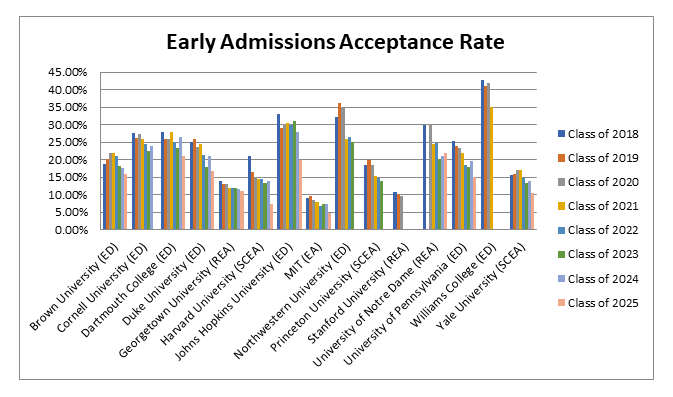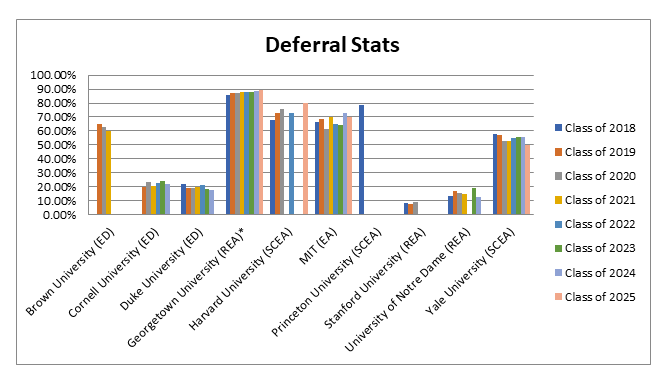 During this unprecedented pandemic, applying early to colleges has had its challenges. From SAT and ACT test cancellations to the reduced ability to visit colleges in person, early admissions have been different this year.
During this unprecedented pandemic, applying early to colleges has had its challenges. From SAT and ACT test cancellations to the reduced ability to visit colleges in person, early admissions have been different this year.
Nevertheless, students have pressed onward and submitted their early apps. Whatever your early admissions outcomes, it is important to have an open mind and to maintain faith in the process of finding your best-fit school. In this blog, we have put together an in-depth analysis of this year’s trends and statistics.
Challenges for the Class of 2025 due to Covid
Class of 2024 deferrals
Due to higher rates of deferral than usual for the Class of 2024, many applicants are wondering how this will affect admissions for the Class of 2025. For example, 20% of this year’s freshmen deferred enrollment at Harvard, and Penn and Yale also reported record high gap years for the Class of 2024. Will there be fewer acceptances this admissions cycle? Jeffrey Selingo, a former editor of The Chronicle of Higher Education, predicts that colleges will actually accept more students from the Class of 2025 and accept more transfer students to the Class of 2024, if possible. He points to the fact that college budgets have suffered during this time and schools need the tuition revenue.
Test date cancellations
As test date after test date had to be cancelled, over 500 colleges switched to a test-optional policy this year. Many students were only able to take the SAT or ACT once, if at all. This leaves students at the disadvantage of being unable to use super-scoring and wondering if test-optional really means test-optional. It absolutely does. However, know that if you do submit scores, the college will review and consider them. Also, college admissions will be relying on high school grades more heavily this year. Penn reported that 38% of all their ED applicants chose not to include test scores, and of those admitted, 24% did not submit test scores. Notre Dame admitted 31% of early applicants without a test score.
Lack of college visits
Restrictions on campus visits, college tours, and meetings with admissions officers at high school events has made it challenging for students to get a sense of the schools in which they are interested in applying, although colleges have tried to increase their presence online through virtual tours and admissions webinars. As a result, many students may have much longer college lists this year compared to previous admissions cycles, which may have contributed to the significant increase in applications.
Fewer interviews
This year, applicants had fewer opportunities to interview at colleges, even virtually. Wake Forest states on their admissions website that their interview season for the Class of 2025 has concluded and that while many applicants were not able to interview, this is an optional part of the application. Wake Forest welcomes applicants “to submit a short, informal email to your regional admissions representative introducing yourself and giving details as to what you would have shared in an interview.” Yale’s admissions website states that applicants should not contact the Yale Alumni Schools Committee for an interview this year. “Because of limited virtual interviewing capacity, the Office of Undergraduate Admissions will prioritize interviews for students for whom the Admissions Committee needs more information. Interviews will remain optional, and students who do not receive an interview will not be disadvantaged.”
Disrupted extracurricular activities
Some activities— such as debate teams and music programs—were able to transition to online platforms, but a sport necessitates in-person competition. Depending on the state that you live in, in-person athletic programs could have been deemed too risky this fall. This will impact athletic recruiting, especially when coaches can’t see students playing in games.
Staying closer to home and financial struggles
Another question facing students is whether to choose a college closer to home during these uncertain times. This will affect students’ college lists and, by extension, colleges’ application numbers. Students whose families are grappling with financial struggles caused by the pandemic could also be looking to lower tuition costs by focusing on public universities versus private universities.
Overall Early Application Trends
So, with all this consider, what has been the impact of Covid-19 on early admissions? According to The New York Times, “the data on early-decision applications this month showed a slightly smaller number of students applying to college, especially from low-income families, although those that did were trying their luck at more schools than usual.”
Early applications numbers at selective schools are up!
In a year filled with uncertainty, more students may have applied early decision to have some certainty. Also, test-optional plans at selective schools that have never had this policy before could have prompted some students to try their luck at colleges which previously seemed out of reach.
Some schools, especially selective schools with test-optional policies, have seen increased early application numbers, including Brown (22% rise in ED apps), Dartmouth (29% rise in ED apps), Duke (16% rise in ED apps), Harvard (57% rise in EA apps), MIT (62% rise in EA apps), Penn (23% rise in ED apps), and Yale (38% rise in EA apps). The University of Georgia has received 27% more EA applications this year compared to last year, and over 30% of those admitted did not submit test scores. The University of Virginia saw a 38% increase in ED apps and a 15% increase in EA applications this year. Northeastern had a 5% increase in EDI apps and a 14% increase in Early Action apps.
Lower early acceptance rates
A rise in applications often leads to a drop in acceptance rates. Penn had a record-low ED acceptance rate of 15%, which dropped almost 5% from last year’s rate. Other schools which reported declining early acceptance rates compared to last year included Dartmouth (5% drop to 21%), Duke (4% drop to 16.7%), Harvard (6.5% drop to 7.4%), MIT (2.6% drop to 4.8%), and Yale (3% drop to 10.5%). Interestingly, Yale expanded its early admit pool by 5% this year compared to last year.
Delayed early application deadlines and notification dates
Many schools extended their early application deadlines, as predicted, and delayed their early deadline from November 1, including Cornell (11/16), Duke (11/16), Fordham (11/9), Tufts (11/17), University of Michigan (11/15), and Villanova (11/15). These dates were most likely moved to give students time to complete additional testing and requirements. The University of Michigan and University of Wisconsin delayed their early notification dates to late January. Last year, early applicants to Michigan and Wisconsin were notified by 12/24 and late December, respectively. Haverford University has pushed back their EDII deadline from January 1 to January 6.
Overall Early Application Numbers
The following graph compares early admissions application numbers and acceptance rates for the class of 2018 through 2025. As a refresher, early decision (ED) is binding and mandates enrollment; single choice early action (SCEA) is restrictive but allows the student to wait until May 1st to decide; and early action (EA) is unrestrictive and non-binding. Early decision is typically associated with higher acceptance rates because the school is guaranteed enrollment, which increases the yield factor, and results in a class comprised of students who have demonstrated a high degree of interest.
Early Admissions Statistics for a Sampling of Selective Colleges
*Notre Dame changed its early admissions program from Early Action to Restrictive Early Action in 2015.
*Stanford last released early admissions stats in 2016. As of the fall 2018, Stanford will no longer publish any admissions data.
*As of 2017, Williams ceased releasing their early decision stats.
*Columbia University does not release early admissions information.
*Princeton cancelled their early admissions program this year and moved to a single admissions deadline of January 1, 2021.
*Notre Dame changed its early admissions program from Early Action to Restrictive Early Action in 2015.
*Stanford last released early admissions stats in 2016. As of the fall 2018, Stanford will no longer publish any admissions data.
*As of 2017, Williams ceased releasing their early decision stats.
*Columbia University does not release early admissions information.
*Princeton cancelled their early admissions program this year and moved to a single admissions deadline of January 1, 2021.
Deferral Stats
Deferral rates are not as widely published as acceptance rates. However, available information shows that many schools defer more than half of their early applicant pool to the regular admissions round.
Notable exceptions include Duke, Middlebury, Northwestern, Notre Dame, and Stanford, who deny most applicants who are not accepted in the early round. For these schools, deferral is used to indicate that your application is competitive and will be given serious consideration in the regular admissions process.
Some schools, like the University of Michigan, use large numbers of deferrals to control class size as they have continued to receive increasingly large early applicant pools. Some colleges defer especially strong candidates who may view the college as a “safe” school, wait to see if the student withdraws the application based on acceptance by more selective colleges, and then may accept the student late-January through March.
For deferred students, there are several steps you can take to increase your chances of admission in Regular Decision, including re-visiting, arranging for an additional letter of recommendation from a 12th grade teacher, and sending a follow-up letter with updates. Above all, stay positive, and continue to do your best academically.
Percent of Early Apps Deferred for Recent Classes
*Georgetown defers all students who are not accepted early action.
*Stanford last released early admissions stats in 2016. As of the fall 2018, Stanford will no longer publish any admissions data.
*Princeton has not released deferral statistics since 2014.
Increased Diversity Continues to be a Priority
Many of the most selective colleges continue to use early admissions for the big “hooks”: underrepresented minorities, lower socioeconomic, first-generation, and international students, as well as recruited athletes, and legacies. Schools with a high percentage of students who self-identify as students of color include Brown (48%), Dartmouth (36%), Harvard (52%), and Penn (50%).
Legacy is another major factor, and schools accepting large numbers of early applicants with a family history of attending the school include Dartmouth (15%), and Penn (22%). In the Ivy League, Penn has the highest rate of legacy acceptances, and recently the Daily Pennsylvanian wrote an article exploring the benefits and drawbacks of this policy.
International early admits continues to grow or remain steady, despite pandemic restrictions on in-person learning. Universities with high international early acceptances include Dartmouth (14%), Harvard (12.2%), and Penn (13%).
If you applied early to a highly selective college and do not fall into one of these categories, consider the even higher odds that you are up against in seeking early admission.
Deciding whether and where to apply early can be daunting, especially now. But whatever your question, Collegiate Gateway is happy to help you decipher your options and understand the changing landscape of early admissions.




